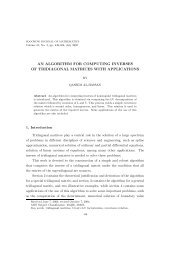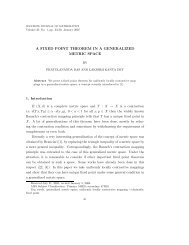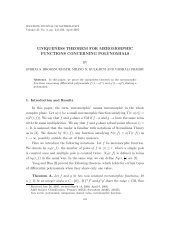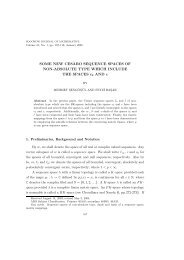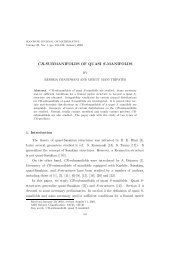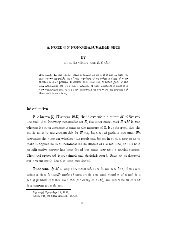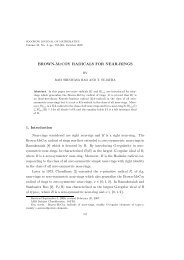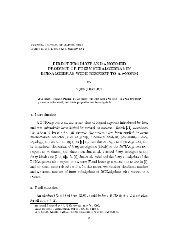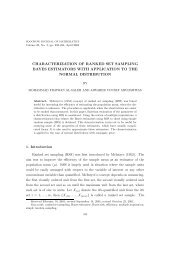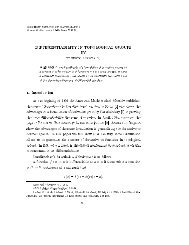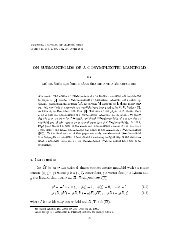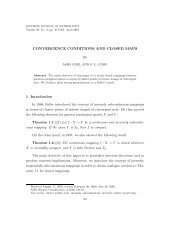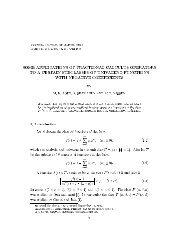intuitionistic m-fuzzy groups - Soochow Journal of Mathematics
intuitionistic m-fuzzy groups - Soochow Journal of Mathematics
intuitionistic m-fuzzy groups - Soochow Journal of Mathematics
Create successful ePaper yourself
Turn your PDF publications into a flip-book with our unique Google optimized e-Paper software.
SOOCHOW JOURNAL OF MATHEMATICS<br />
Volume 30, No. 1, pp. 85-90, January 2004<br />
INTUITIONISTIC M-FUZZY GROUPS<br />
BY<br />
JIANMING ZHAN AND ZHISONG TAN<br />
Abstract. In this paper, we introduce the concept <strong>of</strong> <strong>intuitionistic</strong> M-<strong>fuzzy</strong> <strong>groups</strong><br />
and obtain some results.<br />
1. Introduction and Preliminaries<br />
After the introduction <strong>of</strong> the concept <strong>of</strong> <strong>fuzzy</strong> sets by Zadeh, several researches<br />
were conducted on the generalizations <strong>of</strong> the notion <strong>of</strong> <strong>fuzzy</strong> sets. The<br />
idea <strong>of</strong> “<strong>intuitionistic</strong> <strong>fuzzy</strong> set” was first published by Atanassov[1,2], as a generalization<br />
<strong>of</strong> the notion <strong>of</strong> <strong>fuzzy</strong> sets. Rosenfeld[7] introduced the concept <strong>of</strong> a<br />
<strong>fuzzy</strong> group and Wu[6] studied the <strong>fuzzy</strong> normal subgroup. Gu[3] put forward the<br />
notion <strong>of</strong> the <strong>fuzzy</strong> <strong>groups</strong> with operators. In this paper, we introduce the concept<br />
<strong>of</strong> <strong>intuitionistic</strong> <strong>fuzzy</strong> group with operators and obtain some related results.<br />
For the sake <strong>of</strong> convenience, we set out the former concepts.<br />
Definition 1.1.([7]) A <strong>fuzzy</strong> set A <strong>of</strong> a group G is called a <strong>fuzzy</strong> subgroup<br />
if (1) A(xy) ≥ A(x) ∧ A(y); (2) A(x −1 ) ≥ A(x) for all x, y ∈ G.<br />
Definition 1.2.([4]) A group with operators is an algebraic system consisting<br />
<strong>of</strong> a group G ,asetM and a function defined in the product set M × G and<br />
having values in G such that, if ma denotes the element in G determined by the<br />
element a <strong>of</strong> G and the element m <strong>of</strong> M, thenm(ab) =(ma)(mb) holdsforall<br />
a, b ∈ G and m ∈ M. We shall use the phrases “G is an M-group” to a group<br />
with operators.<br />
Received February 25, 2003; revised May 22, 2003.<br />
AMS Subject Classification. 22F05, 06F10, 03E72, 04A72.<br />
Key words. <strong>intuitionistic</strong> M-<strong>fuzzy</strong> <strong>groups</strong>, homomorphism, M-homomorphism.<br />
85
86 JIANMING ZHAN AND ZHISONG TAN<br />
Definition 1.3.([4]) A subgroup A <strong>of</strong> an M-group G is said to be an M-<br />
subgroup if mx ∈ A for all m ∈ M and x ∈ A.<br />
Definition 1.4.([4]) Let G and G ′ be M-<strong>groups</strong>, f be a homomorphism from<br />
G onto G ′ . If f(mx) =mf(x) for all m ∈ M and x ∈ G, thenf is called an<br />
M-homomorphism.<br />
An <strong>intuitionistic</strong> <strong>fuzzy</strong> set (briefly, IFS) A in a nonempty set X is an object<br />
having the form<br />
A = {(x, α A (x),β A (x))|x ∈ X}<br />
where the functions α A : X → [0, 1] and β A : X → [0, 1] denote the degree <strong>of</strong><br />
membership and the degree <strong>of</strong> nonmembership, respectively, and<br />
0 ≤ α A (x)+β A (x) ≤ 1, ∀x ∈ X.<br />
An <strong>intuitionistic</strong> <strong>fuzzy</strong> set A = {(x, α A (x),β A (x))|x ∈ X} in X can be identified<br />
to an ordered pair (α A ,β A )inI X × I X . For the sake <strong>of</strong> simplicity, we shall use<br />
the symbol A =(α A ,β A )fortheIFS A = {(x, α A (x),β A (x))|x ∈ X}.<br />
2. Intuitionistic M-Fuzzy Sub<strong>groups</strong><br />
Definition 2.1. An IFS A=(α A ,β A ) in a group G is called an <strong>intuitionistic</strong><br />
<strong>fuzzy</strong> subgroup <strong>of</strong> G if<br />
(i) α A (xy) ≥ α A (x) ∧ α A (y) andβ A (xy) ≤ β A (x) ∨ β A (y)<br />
(ii) α A (x −1 ) ≥ α A (x) andβ A (x −1 ) ≤ β A (x)<br />
for all x, y ∈ G.<br />
Definition 2.2. Let G be an M-group and IFS A=(α A ,β A )bean<strong>intuitionistic</strong><br />
<strong>fuzzy</strong> subgroup <strong>of</strong> G. If α A (mx) ≥ α A (x) andβ A (mx) ≤ β A (x) for all<br />
x ∈ G and m ∈ M, thenIFS A=(α A ,β A )issaidtobean<strong>intuitionistic</strong><strong>fuzzy</strong><br />
subgroup with operators <strong>of</strong> G. We use the phrase “A =(α A ,β A )isan<strong>intuitionistic</strong><br />
M-<strong>fuzzy</strong> subgroup <strong>of</strong> G” instead <strong>of</strong> an <strong>intuitionistic</strong> <strong>fuzzy</strong> subgroup with<br />
operators <strong>of</strong> G.<br />
Example 2.3. Let A be an M-subgroup <strong>of</strong> an M-group G and let IFS<br />
A=(α A ,β A ) be an <strong>intuitionistic</strong> <strong>fuzzy</strong> set in G defined by<br />
⎧<br />
⎧<br />
⎨0.7 if x ∈ A<br />
⎨0.2 if x ∈ A<br />
α A (x) =<br />
β<br />
⎩<br />
A (x) =<br />
0.2 otherwise<br />
⎩<br />
0.6 otherwise
INTUITIONISTIC M-FUZZY GROUPS 87<br />
for all x ∈ X. Then it is easy to verify that IFS A=(α A ,β A ) is an <strong>intuitionistic</strong><br />
M-<strong>fuzzy</strong> subgroup <strong>of</strong> G.<br />
Example 2.4. Let G be an M-group while A is a nonempty subset <strong>of</strong><br />
G. If χ A is the characteristic function <strong>of</strong> A, thenA is an M-subgroup <strong>of</strong> G if<br />
and only if IFS A=(χ A , χ A ) is an <strong>intuitionistic</strong> M-<strong>fuzzy</strong> subgroup <strong>of</strong> G, where<br />
χ A (x) =1− χ A (x) for all x ∈ G.<br />
Proposition 2.5. If IFS A=(α A ,β A ) is an <strong>intuitionistic</strong> M-<strong>fuzzy</strong> subgroup<br />
<strong>of</strong> an M-group G, then for any x, y ∈ G and m ∈ M.<br />
(i) α A (m(xy)) ≥ α A (mx) ∧ α A (my) and β A (m(xy)) ≤ β A (mx) ∨ β A (my)<br />
(ii) α A (mx −1 ) ≥ α A (x) and β A (mx −1 ) ≤ β A (x).<br />
Theorem 2.6. Let A be an M-subgroup <strong>of</strong> an M-group G and let IFS<br />
A=(α A ,β A ) be an <strong>intuitionistic</strong> <strong>fuzzy</strong> set in G defined by<br />
⎧<br />
⎨<br />
α A (x) =<br />
⎩<br />
t 1<br />
t 2<br />
⎧<br />
if x ∈ A<br />
⎨s 1 if x ∈ A<br />
β A (x) =<br />
otherwise<br />
⎩<br />
otherwise<br />
for all x ∈ X, t 1 > t 2 and s 1 < s 2 in [0, 1]. Then IFS A=(α A ,β A ) is an<br />
<strong>intuitionistic</strong> M-<strong>fuzzy</strong> subgroup <strong>of</strong> G.<br />
Pro<strong>of</strong>. Assume that A is an M-subgroup <strong>of</strong> G. Letx, y ∈ G. Ifx and y are<br />
in A, thenα A (x) =t 1 = α A (y) andxy ∈ A. Hence α A (xy) =t 1 = α A (x)∧α A (y).<br />
If either x ∉ A or y ∉ A, then either α A (x) =t 2 or α A (y) =t 2 . It follows that<br />
α A (x∗y) ≥ t 2 ≥ α A (x)∧α A (y). Similarly, we have β A (x∗y) ≤ β(x)∨β A (y). Now,<br />
let x ∈ G. Ifx ∈ A, thenα A (x) =t 1 and x −1 ∈ A. Thusα A (x) =t 1 = α A (x −1 ).<br />
If x ∉ A, thenα A (x) =t 2 and x −1 ∉ A. Thusα A (x −1 )=t 2 = α A (x). Similarly,<br />
we have β A (x −1 )=β A (x). Hence IFS A=(α A ,β A ) is an <strong>intuitionistic</strong> <strong>fuzzy</strong><br />
subgroup <strong>of</strong> G. Since A is an M-subgroup <strong>of</strong> G, wehavemx ∈ A for all x ∈ A<br />
and m ∈ M. Therefore α A (mx) =t 1 = α A (x) andβ A (mx) =s 1 = β A (x). If<br />
x ∉ A, thenα A (mx) ≥ t 2 = α A (x) andβ A (mx) ≤ s 2 = β A (x). Consequently,<br />
IFS A=(α A ,β A ) is an <strong>intuitionistic</strong> M-<strong>fuzzy</strong> subgroup <strong>of</strong> G. This completes the<br />
pro<strong>of</strong>.<br />
For any α ∈ [0, 1], the set U(α A ; α) ={x ∈ G|α A (x) ≥ α} (resp. L(α A ; α) =<br />
{x ∈ G|α A (x) ≤ α}) is called an upper (resp. lower) α -level cut <strong>of</strong> α A .<br />
s 2
88 JIANMING ZHAN AND ZHISONG TAN<br />
Theorem 2.7. Let IFS A=(α A ,β A ) be an IFS in an M-group G. ThenIFS<br />
A=(α A ,β A ) is an <strong>intuitionistic</strong> M-<strong>fuzzy</strong> subgroup <strong>of</strong> G if and only if the nonempty<br />
sets U(α A ; α) and L(β A ; α) are M-sub<strong>groups</strong> <strong>of</strong> G for every α ∈ Imα A ∩ Imβ A .<br />
Pro<strong>of</strong>. Let α ∈ Imα A ∩Imβ A ⊆ [0, 1] and x, y ∈ U(α A ; α). Then α A (x) ≥ α<br />
and β A (y) ≥ α. It follows that α A (xy) ≥ α A (x) ∧ α A (y) ≥ α, sothatxy ∈<br />
U(α A ; α). Moreover, if x ∈ U(α A ; α), then α A (x) ≥ α. It follows that α A (x −1 ) ≥<br />
α A (x) ≥ α, and that x −1 ∈ U(α A ; α). Hence U(α A ; α) is a subgroup <strong>of</strong> G.<br />
Now, let x, y ∈ L(β A ; α), then β A (x) ≤ α and β A (y) ≤ α. It follows that<br />
β A (xy) ≤ β A (x) ∨ β A (y) ≤ α, andthatxy ∈ L(β A ; α). Moreover, if x ∈ L(β A ; α),<br />
then β A (x) ≤ α. It follows that β A (x −1 ) ≤ β A (x) ≤ α, andthatx −1 ∈ L(β A ; α).<br />
Hence L(β A ; α) is a subgroup <strong>of</strong> G. For any x ∈ U(α A ; α) andm ∈ M, wehave<br />
α A (mx) ≥ α A (x) ≥ α, andthatmx ∈ U(α A ; α). If x ∈ L(β A ; α) andm ∈ M,<br />
we have β A (mx) ≤ β A (x) ≤ α ,andthatmx ∈ L(β A ; α). Thus U(α A ; α) and<br />
L(β A ; α) areM-sub<strong>groups</strong> <strong>of</strong> G.<br />
Conversely, assume that the nonempty sets U(α A ; α) andL(β A ; α) areMsub<strong>groups</strong><br />
<strong>of</strong> G. Ifthereexistx 0 ,y 0 ∈ G such that α A (x 0 y 0 )
INTUITIONISTIC M-FUZZY GROUPS 89<br />
Lemma 2.8. Let G and G ′ be M-<strong>groups</strong> and f a homomorphism from G<br />
onto G ′ .<br />
(1) If IFS A=(α A ,β A ) is an <strong>intuitionistic</strong> <strong>fuzzy</strong> subgroup <strong>of</strong> G ′ ,thenIFS A f =<br />
(α f A ,βf A<br />
) is an <strong>intuitionistic</strong> <strong>fuzzy</strong> subgroup <strong>of</strong> G.<br />
(2) If IFS A f =(α f A ,βf A<br />
) is an <strong>intuitionistic</strong> <strong>fuzzy</strong> subgroup <strong>of</strong> G, thenIFS<br />
A=(α A ,β A ) is an <strong>intuitionistic</strong> <strong>fuzzy</strong> subgroup <strong>of</strong> G ′ .<br />
Pro<strong>of</strong>. (1) Let x, y ∈ G, wehave<br />
α f A (xy) =α A(f(xy)) = α A (f(x)f(y)) ≥ α A (f(x)) ∧ α A (f(y)) = α f A (x) ∧ αf A (y)<br />
β f A (xy) =β A(f(xy)) = β A (f(x)f(y)) ≤ β A (f(x)) ∨ β A (f(y)) = β f A (x) ∨ βf A (y)<br />
α f A (x−1 )=α A (f(x −1 )) = α A (f(x) −1 ) ≥ α A (f(x)) = α f A (x)<br />
β f A (x−1 )=β A (f(x −1 )) = β A (f(x) −1 ) ≤ β A (f(x)) = β f A (x).<br />
Hence IFS A f =(α f A ,βf A<br />
) is an <strong>intuitionistic</strong> <strong>fuzzy</strong> subgroup <strong>of</strong> G.<br />
(2) For any x, y ∈ G ′ ,thereexista, b ∈ G such that f(a) =x and f(b) =y.<br />
α A (xy) =α A (f(a)f(b)) = α A (f(ab)) = α f A (ab) ≥ αf A (a) ∧ αf A (b) =α A(f(a)) ∧<br />
α A (f(b)) = α A (x) ∧ α A (y); β A (xy) =β A (f(a)f(b)) = β A (f(ab)) = β f A (ab) ≤<br />
β f A (a) ∨ βf A (b) =β A(f(a)) ∨ β A (f(b)) = β A (x) ∨ β A (y); α A (x −1 )=α A (f(a) −1 )=<br />
α A (f(a −1 )) = α f A (a−1 ) ≥ α f A (a)=α A(f(a))=α A (x) andβ A (x −1 )=β A (f(a) −1 )=<br />
β A (f(a −1 )) = β f A (a−1 ) ≤ β f A (a) =β A(f(a)) = β A (x). Hence IFS A=(α A ,β A )is<br />
an <strong>intuitionistic</strong> <strong>fuzzy</strong> subgroup <strong>of</strong> G ′ .<br />
Theorem 2.9. Let G and G ′ be M-<strong>groups</strong> and f an M-homomorphism from<br />
G onto G ′ .IfIFS A=(α A ,β A ) is an <strong>intuitionistic</strong> M-<strong>fuzzy</strong> subgroup <strong>of</strong> G ′ ,then<br />
IFS A f =(α f A ,βf A<br />
) is an <strong>intuitionistic</strong> M-<strong>fuzzy</strong> subgroup <strong>of</strong> G.<br />
Pro<strong>of</strong>. By Lemma 2.8, IFS A f =(α f A ,βf A<br />
) is an <strong>intuitionistic</strong> <strong>fuzzy</strong> subgroup<br />
<strong>of</strong> G. For any x ∈ G and m ∈ M,<br />
α f A (mx)=α A(f(mx)) = α A (mf(x)) ≥ α A (f(x)) = α f A (x);<br />
β f A (mx)=β A(f(mx)) = β A (mf(x)) ≤ β A (f(x)) = β f A (x).<br />
Hence IFS A f =(α f A ,βf A<br />
) is an <strong>intuitionistic</strong> M-<strong>fuzzy</strong> subgroup <strong>of</strong> G.
90 JIANMING ZHAN AND ZHISONG TAN<br />
Theorem 2.10. Let G and G ′ be M-<strong>groups</strong> and f an M-homomorphism<br />
from G onto G ′ .IfIFS A f =(α f A ,βf A<br />
) is an <strong>intuitionistic</strong> M-<strong>fuzzy</strong> subgroup <strong>of</strong><br />
G, thenIFS A=(α A ,β A ) is an <strong>intuitionistic</strong> M-<strong>fuzzy</strong> subgroup <strong>of</strong> G ′ .<br />
Pro<strong>of</strong>. By Lemma 2.8, IFS A=(α A ,β A ) is an <strong>intuitionistic</strong> <strong>fuzzy</strong> subgroup<br />
<strong>of</strong> G ′ . For any y ∈ G ′ and m ∈ M,<br />
α f A (my)=<br />
and<br />
β f A (my)=<br />
sup α A (z) ≥ sup α A (mx) (wherex ∈ f −1 (y))<br />
z∈f −1 (my)<br />
mx∈f −1 (my)<br />
= sup α A (mx) =<br />
f(mx)=my<br />
inf β A(z) ≤<br />
z∈f −1 (my)<br />
= inf<br />
f(mx)=my β A(mx) =<br />
sup α A (mx) ≥<br />
mf(x)=my<br />
inf β A(mx)<br />
mx∈f −1 (my)<br />
inf β A(mx) ≤<br />
mf(x)=my<br />
sup α A (x) =α f A (y)<br />
f(x)=y<br />
(where x ∈ f −1 (y))<br />
inf β A(x) =β f A (y).<br />
f(x)=y<br />
Hence IFS A=(α A ,β A ) is an <strong>intuitionistic</strong> M-<strong>fuzzy</strong> subgroup <strong>of</strong> G ′ .<br />
Acknowledgments<br />
The authors are very grateful to the referees for their advice.<br />
References<br />
[1] K.T.Atanassov,Intuitionistic <strong>fuzzy</strong> sets, Fuzzy Sets and Systems, 20(1986), 87-96.<br />
[2] K. T. Atanassov, New operations defined over the <strong>intuitionistic</strong> <strong>fuzzy</strong> sets, Fuzzy Sets and<br />
Systems, 61(1994), 137-142.<br />
[3] W.X.Gu,S.Y.LiandD.G.Chen,Fuzzy <strong>groups</strong> with operators, Fuzzy Sets and Systems,<br />
66 (1994), 363-371.<br />
[4] N. Jacobson, Lectures in Abstract Algebras, East-West Press, 1951.<br />
[5] Y.B.Jun,Fuzzy BCK/BCI-algebras with operators, Sci. Math., 3(2000), 283-287.<br />
[6] W.M.Wu,Normal <strong>fuzzy</strong> sub<strong>groups</strong>, Fuzzy Math., 1 (1981), 21-23.<br />
[7] A. Rosenfeld, Fuzzy <strong>groups</strong>, J. Math. Anal. Appl., 35(1971), 512-517.<br />
[8] L.A.Zadeh,Fuzzy sets, Inform. & Control, 8(1965), 338-353.<br />
Department <strong>of</strong> <strong>Mathematics</strong>, Hubei Institute for Nationalities, Enshi, Hubei Province, 445000,<br />
P.R. China.<br />
E-mail: zhanjianming@hotmail.com



